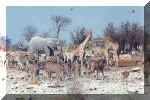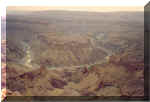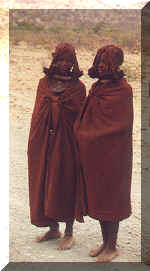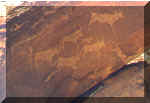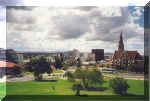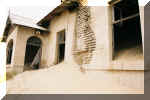| Namib
Naukluft Park - Sossusvlei
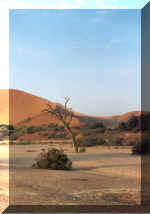
This
sea of dunes is probably Africa's single most breathtaking sight. Here it is possible to
feel truly in tune with nature as you sit amongst the largest sand dunes in the world. The
highest dunes are more than 300m high and it is a tiring experience climbing one of these,
the reward however is a superb view over hundreds of kilometers of sand dunes. The 'vlei'
(pan) is only filled with water during years of exceptional rains, on these rare occasions
huge numbers of birds flock to the area.
The best time to view the
dunes is during sunrise or sunset when the constantly changing light creates a
kaleidoscope effect, as the dunes change colour while you watch. The area is also home to
Oryx and it is not unusual to spot one of these majestic animals moving across the
horizon.
Naukluft
The Naukluft is situated on the
eastern side of the Namib desert. Its name comes from a narrow kloof on the eastern
side of the mountains. The area is ideal hiking country and the rugged mountains,
deep ravines and clear pools surprise many a visitor.
Two daywalks are marked in the
Naukluft, the Waterkloof trail (± 17 km long) and the Olive trail (± 10 km).
Another challenge is the 4 or 8-day hiking trail, but make sure you are fit !
The massif of the Naukluft is the
home of many animals typical of the highlands, such as the mountain zebra and
klipspringer. Other animals that can be seen are kudu, springbok, oryx and small
antelope like duiker and steenbok. Predators are seldom seen but are present;
leopard, African wild cat, caracal, etc.
During the early 1890's the
Naukluft was the scene of a conflict between the Germans and the Witbooi Namas.
Hendrik Witbooi refused to submit to the supreme authority of the German emperor. A
campaign, lead by major Curt von François, was launched against Witbooi. Witbooi
was forced to retreat from his settlement at Hoornkranz, but the Germans did not manage to
defeat him. He retreated into the Naukluft mountains. Between April 1893 and
September 1894 several fights took place between the German troupes and the Witbooi
Namas. After heavy losses on both sides, Witbooi offered to negociate. He
accepted the paramouncy of the German emperor, allowed a garrison to be stationed at
Gibeon but he and his followers were to retain their weapons and Witbooi
retained his
territory and control over his subjects and their land.
 Northern
Namib Northern
Namib
In the northern section of the Namib-Naukluft park, between
the Kuiseb river in the south and the Swakop river in the north, lies the seemingly barren
and lifeless desert of the Namib. On closer inspection however visitors will
discover a variety of life forms, each uniquely adapted to life in the desert. The
area is characterised by flat gravel plains, occasionally broken by granite outcrops.
The Welwitschia drive
is accessible in a normal sedan car and allows the visitor to discover this
beautiful area. A permit is required.
The Namib section is
home to zebra, springbok, oryx, hyena, jackal, Cape fox, bat-eared fox, barking gecko,
Namaqua chameleon and many others. Amongst the many birds you will find lappetfaced
vulture, Gray's lark and ostrich.
For information on facilities
& accommodation, see Namib Naukluft Park
|
